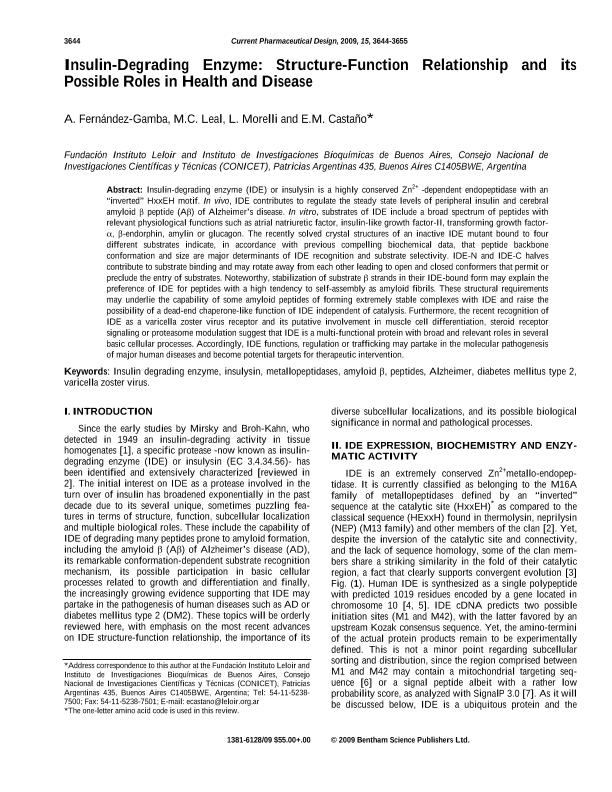Mostrar el registro sencillo del ítem
dc.contributor.author
Fernandez Gamba, Agata Claudia

dc.contributor.author
Leal, Maria Celeste

dc.contributor.author
Morelli, Laura

dc.contributor.author
Castaño, Eduardo Miguel

dc.date.available
2021-08-05T16:01:07Z
dc.date.issued
2009-11
dc.identifier.citation
Fernandez Gamba, Agata Claudia; Leal, Maria Celeste; Morelli, Laura; Castaño, Eduardo Miguel; Insulin-degrading enzyme: Structure-function relationship and its possible roles in health and disease; Bentham Science Publishers; Current Pharmaceutical Design; 15; 31; 11-2009; 3644-3655
dc.identifier.issn
1381-6128
dc.identifier.uri
http://hdl.handle.net/11336/137874
dc.description.abstract
Insulin-degrading enzyme (IDE) or insulysin is a highly conserved Zn 2+-dependent endopeptidase with an "inverted" HxxEH motif. In vivo, IDE contributes to regulate the steady state levels of peripheral insulin and cerebral amyloid β peptide (Aβ) of Alzheimer's disease. In vitro, substrates of IDE include a broad spectrum of peptides with relevant physiological functions such as atrial natriuretic factor, insulin-like growth factor-II, transforming growth factor-α, β-endorphin, amylin or glucagon. The recently solved crystal structures of an inactive IDE mutant bound to four different substrates indicate, in accordance with previous compelling biochemical data, that peptide backbone conformation and size are major determinants of IDE recognition and substrate selectivity. IDE-N and IDE-C halves contribute to substrate binding and may rotate away from each other leading to open and closed conformers that permit or preclude the entry of substrates. Noteworthy, stabilization of substrate β strands in their IDE-bound form may explain the preference of IDE for peptides with a high tendency to self-assembly as amyloid fibrils. These structural requirements may underlie the capability of some amyloid peptides of forming extremely stable complexes with IDE and raise the possibility of a dead-end chaperone-like function of IDE independent of catalysis. Furthermore, the recent recognition of IDE as a varicella zoster virus receptor and its putative involvement in muscle cell differentiation, steroid receptor signaling or proteasome modulation suggest that IDE is a multi-functional protein with broad and relevant roles in several basic cellular processes. Accordingly, IDE functions, regulation or trafficking may partake in the molecular pathogenesis of major human diseases and become potential targets for therapeutic intervention.
dc.format
application/pdf
dc.language.iso
eng
dc.publisher
Bentham Science Publishers

dc.rights
info:eu-repo/semantics/openAccess
dc.rights.uri
https://creativecommons.org/licenses/by-nc-sa/2.5/ar/
dc.subject
ALZHEIMER
dc.subject
AMYLOID Β
dc.subject
DIABETES MELLITUS TYPE 2
dc.subject
INSULIN DEGRADING ENZYME
dc.subject
INSULYSIN
dc.subject
METALLOPEPTIDASES
dc.subject
PEPTIDES
dc.subject
VARICELLA ZOSTER VIRUS
dc.subject.classification
Neurología Clínica

dc.subject.classification
Medicina Clínica

dc.subject.classification
CIENCIAS MÉDICAS Y DE LA SALUD

dc.title
Insulin-degrading enzyme: Structure-function relationship and its possible roles in health and disease
dc.type
info:eu-repo/semantics/article
dc.type
info:ar-repo/semantics/artículo
dc.type
info:eu-repo/semantics/publishedVersion
dc.date.updated
2021-07-01T17:31:58Z
dc.identifier.eissn
1873-4286
dc.journal.volume
15
dc.journal.number
31
dc.journal.pagination
3644-3655
dc.journal.pais
Estados Unidos

dc.journal.ciudad
Oak Park
dc.description.fil
Fil: Fernandez Gamba, Agata Claudia. Consejo Nacional de Investigaciones Científicas y Técnicas. Oficina de Coordinación Administrativa Parque Centenario. Instituto de Investigaciones Bioquímicas de Buenos Aires. Fundación Instituto Leloir. Instituto de Investigaciones Bioquímicas de Buenos Aires; Argentina
dc.description.fil
Fil: Leal, Maria Celeste. Consejo Nacional de Investigaciones Científicas y Técnicas. Oficina de Coordinación Administrativa Parque Centenario. Instituto de Investigaciones Bioquímicas de Buenos Aires. Fundación Instituto Leloir. Instituto de Investigaciones Bioquímicas de Buenos Aires; Argentina
dc.description.fil
Fil: Morelli, Laura. Consejo Nacional de Investigaciones Científicas y Técnicas. Oficina de Coordinación Administrativa Parque Centenario. Instituto de Investigaciones Bioquímicas de Buenos Aires. Fundación Instituto Leloir. Instituto de Investigaciones Bioquímicas de Buenos Aires; Argentina
dc.description.fil
Fil: Castaño, Eduardo Miguel. Consejo Nacional de Investigaciones Científicas y Técnicas. Oficina de Coordinación Administrativa Parque Centenario. Instituto de Investigaciones Bioquímicas de Buenos Aires. Fundación Instituto Leloir. Instituto de Investigaciones Bioquímicas de Buenos Aires; Argentina
dc.journal.title
Current Pharmaceutical Design

dc.relation.alternativeid
info:eu-repo/semantics/altIdentifier/url/https://www.eurekaselect.com/70146/article
dc.relation.alternativeid
info:eu-repo/semantics/altIdentifier/doi/http://dx.doi.org/10.2174/138161209789271799
Archivos asociados
